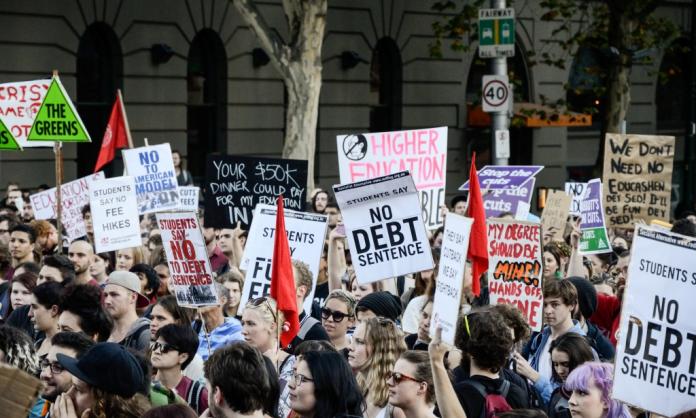The federal government has taken a cleaver to universities. In a package of measures that education minister Dan Tehan refers to as a “reshaping of the architecture of higher education” on the scale of the post-World War Two changes to universities, student fees will skyrocket and public funding will be slashed. The move is yet another attempt by the Liberal Party to shift our universities towards a US-style model.
Student fees for humanities subjects will more than double, while law and commerce will increase by a third. If the changes get through the Senate, they will result in the biggest student fee increase since the Howard government’s changes to the HECS scheme in 1996. As well as the economic burden this will put on students, it’s also an attack on the idea that studying is worthwhile and fulfilling beyond acquiring the skills necessary for capitalist industry. This is particularly relevant to arts degrees, which are some of the most popular not because they provide guaranteed jobs, but because they are viewed as a way to gain a deeper understanding of society and history.
The government wants to transform universities into factories for producing “job-ready graduates” for industries deemed useful and profitable for the Australian economy. The student cost of degrees such as science and nursing will be reduced, but the cuts in government funding for these areas means the quality of education will likely suffer. This is further indicated by government policies that incentivise universities and other education providers to award “micro-credentials” for short courses that upskill employees on the cheap. It’s not hard to see how this approach will benefit the Liberal Party’s friends in the shadowy and highly corrupt private college sector.
One of the core aspects of the proposed package is the undermining of universities as public institutions. If these policies succeed, the government contribution to fees will be reduced from 58 percent to 48 percent. This will force universities to seek more private funding, a process that will inevitably skew the learning that takes place.
The ruling class has long held the view that higher education in Australia should be reshaped according to the US model: universities being run as highly profitable corporations that treat students as customers. It is a notoriously stratified system, offering an exclusive product to rich students at Ivy League colleges while extorting working class students and crippling them with lifelong debt. Successive governments and universities have aspired to shape the university sector around these principles.
They have made substantial inroads. Since the introduction of a flat fee in 1989, the average cost of a degree for domestic students has ballooned more than one hundredfold. Most domestic students access university through the HECS government loan scheme, but there is also a steady increase in places available to those paying full fees. At the same time, government funding to universities has dramatically decreased, Australian universities ranking among the lowest in the OECD in terms of government funding.
But by far the biggest step towards entrenching a user-pays model has been the expansion of the international student market. The fleecing of international students generated $39 billion for the Australian economy last year. Universities have used the extra money to further expand and develop deeper connections with the corporate sector. Sydney University’s partnerships with Telstra, Microsoft and Rio Tinto are typical. And it is nearly impossible to walk through any major city in Australia without seeing signs that business is booming: university logos adorn building after building, representing both growing campuses and growing real estate portfolios. Melbourne University owns 101 buildings in addition to its own campuses.
Universities are also run as corporations internally. Over recent years, there have been numerous campus “restructures” resulting in unprecedented rounds of mass sackings, the cutting of “inefficient” courses and services and proclamations from university managements about the brave new world of “flexibility, agility and progress” that they have created. University staff are now one of the most casualised groups of workers; several campuses have a casualisation rate above 70 percent.
Even this neoliberal boom story does not go far enough, from the perspective of some in the ruling class. Most Australian universities are still publicly owned and are still restricted in the amount they can charge domestic students. And there is still a widespread belief in a mass, accessible education system for the sake of learning and enrichment.
But the COVID-19 crisis could prove to be the ultimate circuit breaker. The onset of the pandemic hit universities hard, exposing their over-reliance on international students. Despite most universities having substantial reserves to fall back on, they are looking for ways to cut costs and diversify their business models. More broadly, the onset of a recession and the likelihood that it will be deep and long lasting provides further incentive to their long-held agenda of economic rationalism and austerity.
Beyond the emergence of a new economic landscape, the COVID-19 crisis has provided cover under which university managements and the government can make slashing changes, consolidate years of neoliberal attacks and conclusively redefine universities as expensive degree factories, churning out work-ready graduates. Already, universities have laid off thousands of staff, launched attacks on wages and conditions and signalled that many faculties and courses will be slashed. The government has now joined in and has indicated that its “job-ready graduates” policy package is just the beginning of its campaign.
After years of gradual attacks, we’re now faced with a drastic and historic restructure. It’s up to students and staff to resist. NTEU Fightback, a group of rank-and-file workers from the National Tertiary Education Union, have set an example. They have been standing strong against pay cuts and against disgraceful attempts by the union leaders to pre-emptively accept the cuts under the threat of more sweeping sackings. But university managers will continue to pursue both pay cuts and sackings. It will be important for workers to continue to resist, and for students to stand in solidarity with them.
Students now preparing to fight this fee hike should take confidence from the fact that the last major attempt to bring in enormous fees and consolidate the US model was routed. In 2014, the Abbott Liberal government proposed fee deregulation, which would have resulted in the cost of some degrees rising to as much as $100,000. This attempt was defeated by a national student campaign involving mass rallies and the constant haranguing of Liberal ministers by angry students who confronted them wherever they went.
Much of that campaign needs to be repeated today. We need to organise mass street demonstrations in every city, as well as campus-based actions and stunts. We need to provide a counter-narrative to the government’s spin, not through parliamentary submissions and lobbying ministers but through a defiant, fighting movement. We also need to argue that the government proposal is part of a broader agenda of cuts and that the way we respond to this attack will set a tone for how to fight future attacks.
We also need to take this opportunity to respond to Tehan’s vision of a reshaped architecture with our own vision of how education should look. We need to fight for an education system that is not based on the latest pragmatic needs of the ruling class, that financially excludes working class students from education or that focusses on making them work ready for the capitalists. We demand nothing less than a free, fully funded and democratic education system.









